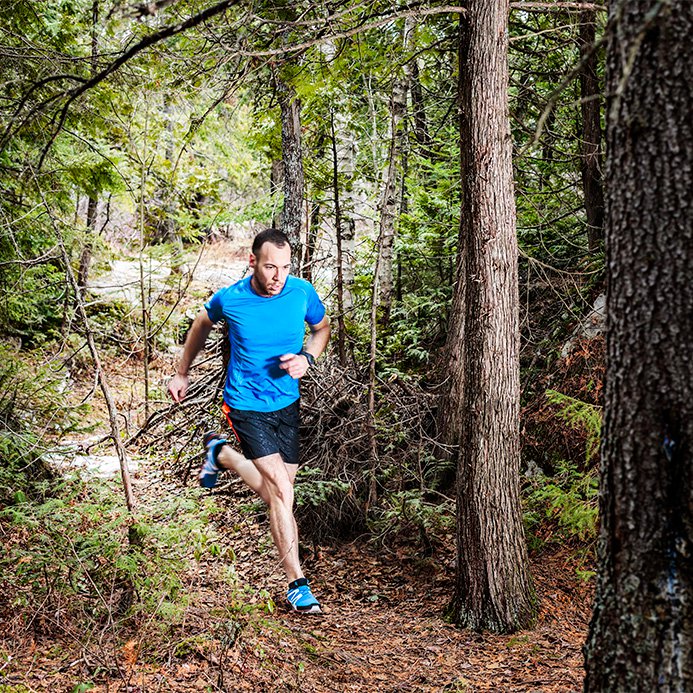
One of the greatest reasons running is a fabulous activity, is that you can do it in so many different places. You can take in nature on the trails, run a specific hill or speed workout on a treadmill or hit your neighborhood streets. But before you venture off, it’s important to know the differences in the path you take.
Trail Running
Pros: The joy of navigating a trail can be summed up in three words – in the moment. When you’re running on uneven trail, it demands your full attention and brings you into a zen-like state. You can’t think about the laundry list of items that needs to get done or hash through the latest drama. You’ve got to be right there thinking about the next step you take, and the next, and the next. Before you know it, you’re finishing up and your stress level is all but gone. Similar to mountain biking, it develops running strength and finesse and decreases the risk of over use injuries due to running in the same wear pattern on more predictable terrain and because the terrain is soft, it is more forgiving on the body which translates to less impact.
Cons: Although the view is scenic and refreshing, nature also means insects that bite, isolated areas and animals. The more technical the trail, the more energy it demands and it requires time to adapt and learn the skills to run efficiently.
Paved or Limestone Path
Pros: This terrain is the little black dress for runners. It offers the stability of an evenly graded sidewalk, with the forgiveness of an asphalt road or trail, without automobile traffic. Many paved and limestone paths are marked so it can be a good way to develop your pacing skills and perform speed workouts as you can run uninterrupted.
Cons: Although beautiful, many of these bike paths run through secluded areas and forests. Always run in groups, carry ID and cell phone and be aware of your surroundings. Keep your ears to the path so to hear bike and recreational traffic coming from behind you.
Treadmill Running
Pros: Among the many benefits, the treadmill provides convenience and safety. It is there for you at 5 am so you can get in that early morning run before your meeting. It’s there for you when it’s storming and dark outside. The treadmill allows you to modify and control your speed and elevation and easily see your pace along the way. Like trail running, the impact forces are more forgiving than the roads making it a great resource for runners who are new, prone to injuries or trying to improve performance with less risk.
Cons: Although you’re running, the movement is different than the outdoors in that you’re keeping up with the tread rather than propelling yourself forward.
Road Running
Pros: Running the roads can be as inspiring as a scene out of Forrest Gump. There are a plethora of options and roads to explore and you can start right outside your doorstep or hotel room. The asphalt is easier on the muscles, joints and tendons than the sidewalk. Although there still may be some points you’ll need to stop and go for lights and traffic, you can generally get into a continuous running tempo.
Cons: Many road and streets are cambered with a crown or peak in the center and an angle toward the side of the road. Running on an uneven surface can create muscle imbalance and alignment issues including knee and ITB pain as one leg is landing slightly higher on the ground than the other. Safety is an issue, especially with high speed traffic and distracted drivers. Always be sure to run against traffic to see and be seen.
Track
Pros: Your local high school track is a safe place to run your mileage as you’re off the busy streets and out of traffic. Most tracks are measured and marked where four laps equal one mile and therefore it is a great way to learn how to pace yourself naturally. All you need is your shoes and a watch or timer. The track is also a predictably flat surface and a great place to learn to run and perform speed workouts. A bonus benefit many tracks are made from a forgiving rubber material that it easy on the muscles, tendons and joints.
Cons: Unless you live by a track, getting there can be a hassle for the busy-minded runner and some tracks have limited public access usage. Running in a circle can become monotonous for some runners who enjoy the sense of exploration.
Sidewalk
Pros: A safe, out of the line of traffic place to run, especially in urban areas and in the darkness. Many sidewalks, if in good condition, provide a predictable and even (not cambered) terrain, which allows for better running form and alignment.
Cons: The concrete sidewalk surface is much harder than asphalt and create greater impact forces on the body versus the road, track or path. You may need to stop and start to cross streets, navigate pedestrians and other obstacles on the sidewalk throughout your run, not allowing for a continuous flow and pace.
Coach Jenny Hadfield is a published author, writer, coach, public speaker and endurance athlete. To find out more, visit our Meet Our Writers page or visit Coach Jenny’s website.

